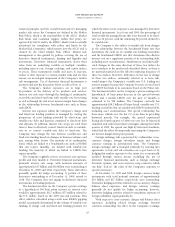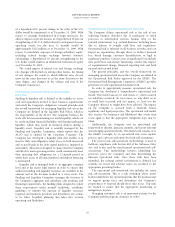American Express 2009 Annual Report Download - page 60
Download and view the complete annual report
Please find page 60 of the 2009 American Express annual report below. You can navigate through the pages in the report by either clicking on the pages listed below, or by using the keyword search tool below to find specific information within the annual report.
2009 FINANCIAL REVIEW
AMERICAN EXPRESS COMPANY
RESULTS OF OPERATIONS FOR THE THREE YEARS
ENDED DECEMBER 31, 2009
GCS reported segment income of $390 million for 2009, a
$115 million or 23 percent decrease from $505 million in
2008, which decreased $31 million or 6 percent from 2007.
Total Revenues Net of Interest Expense
In 2009, GCS’ total revenues net of interest expense decreased
$650 million or 14 percent to $4.0 billion due to decreased
discount revenue, net card fees, and other revenues and lower
interest income, partially offset by lower interest expense.
Discount revenue, net card fees, and other revenues decreased
$924 million or 18 percent to $4.2 billion in 2009 primarily
driven by lower travel commissions and fees, the reduced level
of card spending, decreased other revenues and reduced other
commissions and fees. The 14 percent decrease in billed
business in 2009 reflected a 16 percent decrease in average
spending per proprietary basic card. Assuming no changes in
foreign currency exchange rates from 2008 to 2009, billed
business and average spending per proprietary basic card
decreased 11 percent and 13 percent, respectively, in 2009
with volume decreases within the United States of 11 percent
compared to results within the Company’s other major
geographic regions ranging from the mid-teen-digit declines
in Europe and Asia Pacific, a low-teen-digit decrease in
Canada, and a mid-single-digit increase in Latin America4.
Interest income decreased $107 million or 64 percent to $61
million in 2009 compared to 2008, driven by lower rates
within deposit-related income. Interest expense decreased
$381 million or 69 percent to $172 million in 2009 compared
to 2008 due to a lower cost of funds and average receivable
balance, partially offset by the cost of funding the CPS
acquisition. Total revenues net of interest expense of $4.7
billion in 2008 were $427 million or 10 percent higher than
2007 due to increased discount revenue, net card fees, and
other revenue and lower interest expense.
Provisions for Losses
Provisions for losses decreased $54 million or 23 percent to
$177 million in 2009 compared to 2008, reflecting improved
credit trends as 2009 progressed. Provisions for losses
increased $68 million or 42 percent to $231 million in 2008
compared to 2007, reflecting higher loss and past due rates
due to the challenging economic environment.
4Refer to footnote 2 on page 34 under Consolidated Results of
Operations for the Three Years Ended December 31, 2009 relating
to changes in foreign exchange rates.
Expenses
During 2009 GCS’ expenses decreased $471 million or 12
percent to $3.3 billion, reflecting a reduction of $426 million
in salaries and employee benefits and other operating
expenses as described below, as well as lower rewards costs,
lower net charges associated with reengineering initiatives in
2009, and the Delta-related increase in the Membership
Rewards balance sheet reserve in the fourth quarter of 2008.
Expenses in 2009, 2008 and 2007, included $101 million, $138
million, and $25 million, respectively, of reengineering costs,
primarily reflecting the Company’s reengineering initiatives
in 2009 and 2008 as previously discussed and reengineering
costs, primarily in business travel in 2007. Expenses in 2008 of
$3.8 billion were $410 million or 12 percent higher than 2007,
primarily due to greater salaries and employee benefits and
other operating expenses.
Marketing, promotion, rewards and cardmember services
expenses decreased $45 million or 12 percent to $332 million
in 2009 compared to 2008, primarily reflecting lower rewards
costs in 2009 and the Delta-related increase in the
Membership Rewards balance sheet reserve in the fourth
quarter of 2008. Marketing, promotion, rewards and
cardmember services expenses decreased $10 million or 3
percent to $377 million in 2008 compared to 2007, primarily
due to the Membership Rewards related charge in 2007, offset
by higher volume-related rewards costs and the Delta-related
charge in 2008 to increase the Membership Rewards liability.
Salaries and employee benefits and other operating expenses
decreased $426 million or 13 percent to $3.0 billion in 2009
compared to 2008, reflecting the benefits from the Company’s
reengineering initiatives, partially offset by lower net charges
associated with these programs during 2009. Salaries and
employee benefits and other operating expenses increased
$420 million or 14 percent to $3.4 billion in 2008 compared
to 2007, due to higher other operating expenses and greater
salaries and employee benefits expense, which reflected the
impacts of the CPS acquisition, as well as the costs related to
the Company’s reengineering initiatives in 2008 and the
pension-related gain in 2007.
Income Taxes
The effective tax rate was 31 percent in 2009 versus 27 percent
in 2008 and 28 percent in 2007.
58
























